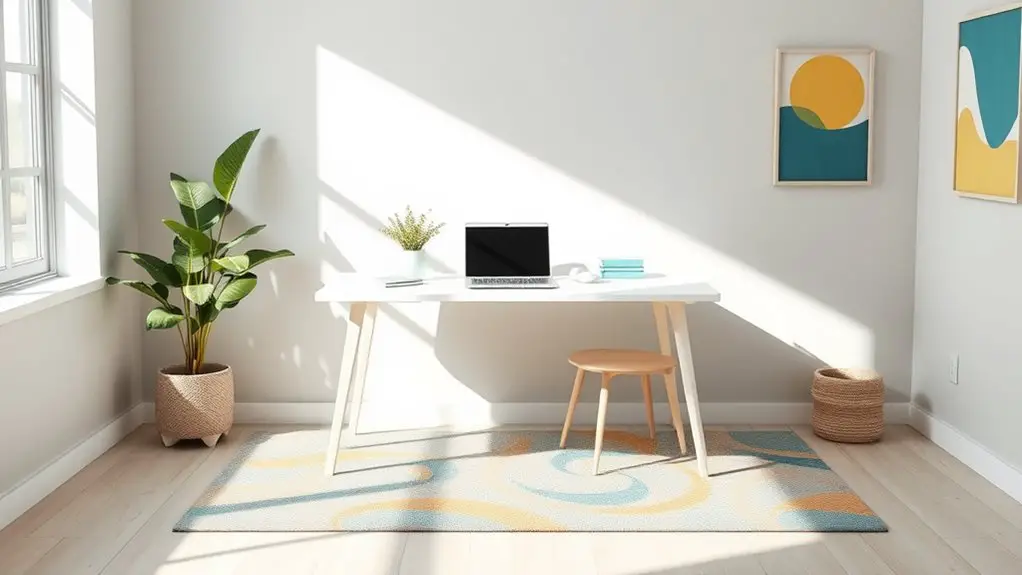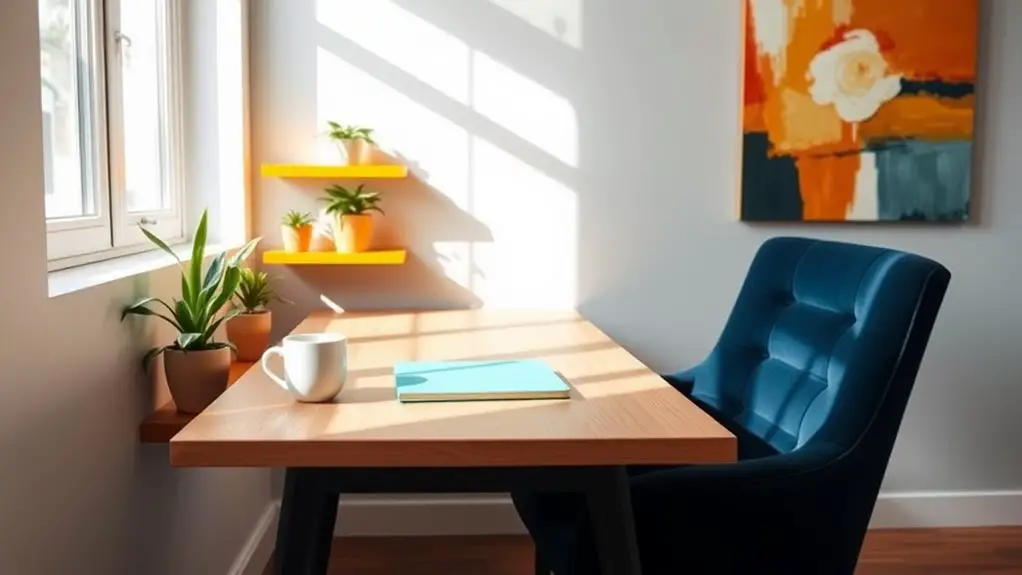To choose a color scheme that boosts productivity, focus on calming blues and tranquil greens for individual tasks, or incorporate vibrant yellows and bright blues for collaborative spaces. Balance energizing oranges with calm colors to keep your workspace dynamic yet focused. Remember that effective combinations, like green and yellow, can enhance collaboration. Make sure to think about how colors influence emotions and productivity. There's so much more to discover about creating an ideal work environment.
Key Takeaways
- Select calming colors like blues and greens to enhance focus and create a serene work environment.
- Incorporate energizing colors like yellow and orange for collaborative spaces to stimulate creativity and enthusiasm.
- Use color combinations thoughtfully; pair blues with whites for organization and calmness in your workspace.
- Limit your color palette to a few key colors to maintain focus and improve readability in digital interfaces.
- Ensure accessibility by considering color blindness and contrast to create an inclusive and productive design.
Understanding the Emotional Impact of Colors

Colors play an essential role in shaping our emotions and behaviors, often without us even realizing it. When you encounter warm colors like red and yellow, you might feel invigorated and lively. In contrast, cool colors such as blue and green evoke a sense of calm and security.
Emotional responses to colors are consistent worldwide, with red signifying both love and anger, while blue conveys trust. Brighter and more saturated colors typically raise your arousal levels and enhance pleasant feelings. Color psychology studies link colors to mood changes, demonstrating how they can significantly influence your work environment.
You'll likely find hues like blue and green to be the most enjoyable, while darker shades can elicit negative emotions. Understanding these emotional impacts can help you make informed choices when selecting colors for your environment to boost productivity effectively.
Selecting Colors for Different Productivity Needs
Understanding how colors affect emotions can guide you in selecting the right palette for different productivity needs. For individual focus, consider calming blues and tranquil greens. In collaborative environments, vibrant blues and bright yellows can enhance creativity. For task-oriented work, calm blues and energizing oranges can boost productivity. Research shows that specific colors like green can lower stress levels and potentially boost focus by 25%.
Here's a quick reference table to help you choose:
| Productivity Need | Recommended Colors |
|---|---|
| Individual Focus | Blue, Green |
| Collaborative Environments | Vibrant Blue, Bright Yellow |
| Task-Oriented Work | Calm Blue, Energizing Orange |
The Influence of Color Combinations

When you combine colors thoughtfully, you can greatly enhance the productivity of your workspace.
The right combinations not only influence mood but also foster an environment conducive to focus and creativity.
Here are three effective color combinations to reflect upon:
- Blue and White: This pairing brings calmness and openness, promoting a clean, organized workspace.
- Red and Orange: These vibrant colors stimulate energy and creativity, but use them sparingly to prevent overstimulation.
- Green and Yellow: This dynamic duo balances energy and promotes collaboration, making it ideal for team settings.
Optimizing Color in Digital Interfaces
Thoughtful color combinations can greatly enhance not just physical workspaces but also digital interfaces. Colors evoke emotions and influence how users perceive your digital products. For instance, red sparks urgency, making it perfect for calls to action, while blue builds trust and stability. When selecting your palette, consider hue, shade, and contrast; complementary colors can create visual distinction. Aim for fewer colors to maintain focus and guarantee readability—dark backgrounds with light text work best.
Don't overlook accessibility; keep color blindness in mind. Additionally, understanding color psychology is essential for driving conversions and enhancing user engagement. Finally, remember that up to 90% of product assessment is based on color alone, so choose wisely to optimize user experience and engagement.
Using tools like Adobe Kuler can simplify the process of finding the right scheme.
Creating a Personalized Work Environment

Creating a personalized work environment can greatly boost your productivity and overall job satisfaction.
When you tailor your workspace to fit your needs, you create a more comfortable and inspiring atmosphere. Here are three key elements to contemplate:
- Ergonomic Furniture: Choose chairs and desks that reduce physical strain and enhance comfort, allowing you to focus better. Improved employee retention rates can also stem from a well-designed workspace that meets individual needs.
- Customizable Decor: Incorporate personal touches like photos or artwork that reflect your personality and make the space feel welcoming.
- Lighting and Temperature: Adjust lighting to minimize eye strain and manage the temperature to keep the environment comfortable, promoting a positive mood.
Frequently Asked Questions
How Do Colors Affect Decision-Making in Group Settings?
Colors considerably affect decision-making in group settings. You'll notice that red can create urgency, while blue promotes trust. Using yellow energizes discussions, and green fosters balance, ultimately shaping how your group interacts and makes choices.
Can Colorblind Individuals Experience Color's Emotional Effects?
Yes, colorblind individuals can still experience color's emotional effects. While their perception differs, they often respond emotionally to colors. Using accessible palettes can enhance their experience, ensuring they still feel the intended emotional impact.
What Colors Are Best for Remote Work Environments?
For remote work environments, choose calming colors like blue and green to enhance focus and reduce stress. Incorporate energizing accents like yellow or orange for creativity, while ensuring a neutral base for balance and distraction-free productivity.
How Often Should I Change My Color Scheme?
You should change your color scheme periodically, ideally every few years, to keep things fresh. Regular updates can enhance engagement, reflect your brand's evolution, and maintain relevance with your audience and employees' preferences.
Are There Colors That Universally Improve Productivity for Everyone?
Yes, certain colors like blue and green generally enhance productivity by promoting creativity and reducing stress. However, individual preferences and cultural backgrounds can influence how effectively these colors work for you.
